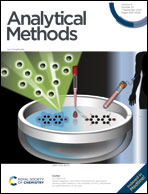Electrochemical biosensing based on folic acid-triazine-grafted reduced graphene oxide: a highly selective breast cancer cell sensor†
Abstract
Based on the results of this research, a new electrochemical sensor has been developed to detect human breast cancer cells (MCF-7). A folic acid (FA)-functionalized triazine-grafted reduced graphene oxide (RGOTrz) was used as the modifier of a glassy carbon electrode (GCE) for application as the sensing element. The composition of the resulting FA-RGOTrz/GCE was investigated using XRD (X-ray diffraction), FT-IR (Fourier-transform infrared) spectroscopy, SEM (scanning electron microscopy) and UV-vis spectroscopy studies. CV (cyclic voltammetry) and EIS (electrochemical impedance spectroscopy) techniques were also used to characterize the electrochemical proficiency of the new electrode. Further, MCF-7 cancer cells were examined in solutions of phosphate buffer and [Fe(CN)6]3−/4− as a suitable supporting electrolyte and a useful probe, respectively. The FA-RGOTrz/GCE provides a suitable substrate to reversible redox reactions and provides good electrochemical signals after binding to cancer cells. DPV (differential pulse voltammetry) results indicated that the binding of folate receptor (FR) in the MCF-7 cell to the RGOTrz-modified electrode, in the presence of [Fe(CN)6]3−/4−, reduced folic acid, diminished electron transfer and collapsed the current signal. During the measured flow, a detection limit of 50 human breast cancer cells per milliliter was obtained. The FA-RGOTrz/GCE, with its unique structural design, significantly increases the electron transfer and electrochemical activity towards the detection of MCF-7 cells. This FA-RGOTrz/GCE sensor, due to its special structure, shows high sensitivity to FR in MCF-7 cells and excellent, reliable and satisfactory performance and a great promise for use in industries and medical field.



 Please wait while we load your content...
Please wait while we load your content...